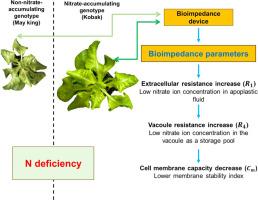电生物阻抗谱作为无损监测两种生菜基因型氮素供应的工具
IF 4.2
2区 农林科学
Q1 HORTICULTURE
引用次数: 0
摘要
准确监测养分供应对有效的植物营养管理至关重要。本研究介绍了生物阻抗谱(BIS)方法来评估生菜基因型对氮(N)供应的响应,阐明了BIS与氮代谢之间的联系。研究包括两个部分:一个初步试验侧重于细胞外液抗性,然后是第二个试验,涉及对两种基因型生菜施用五种不同的氮处理。在1 Hz至100 kHz范围内记录了BIS光谱,共测量了224次。植物生理分析评估了总硝酸盐和细胞外液(NO3−)浓度、色素浓度、总氮含量和细胞膜稳定性指数。在初步实验中,细胞外液NO3−浓度与细胞外液阻力呈显著负相关(r = - 0.67)。此外,“Kobak”生菜基因型在63 Hz左右的频率范围(R2 = 0.97)对NO3−动态最敏感。在5种不同氮处理的2个基因型生菜中,细胞外液抗性与总氮和NO3 -含量呈负相关(r = - 0.76和- 0.73),液泡液抗性呈中等相关(r = - 0.51)。细胞膜电容也与膜稳定性指数显著相关(r = 0.68),表明低氮条件降低了膜电荷储存。然而,这些相关性似乎高度依赖于基因型。基于热图的Z-score标准化BIS参数分层聚类进一步证实了这些基因型特异性模式。总的来说,这些发现表明BIS捕获了氮摄取和储存的关键方面,特别是在细胞外液区。总的来说,BIS提供了一种强大的、非破坏性的监测氮状态的方法,可以提高生菜和其他作物营养管理的准确性,尽管必须仔细考虑基因型特异性差异。本文章由计算机程序翻译,如有差异,请以英文原文为准。

Electrical bioimpedance spectroscopy as a tool for non-destructive monitoring nitrogen supply in two lettuce genotypes
Accurate monitoring of nutrient supply is crucial for effective plant nutrition management. This study introduces a bioimpedance spectroscopy (BIS) approach to evaluate how lettuce genotypes respond to nitrogen (N) supply, illuminating the link between BIS and N metabolism. The research consisted of two parts: a preliminary experiment focusing on extracellular fluid resistance, followed by a second experiment involving five different N treatments applied to two lettuce genotypes. BIS spectra were recorded from 1 Hz to 100 kHz, with a total of 224 measurements. Plant physiological analyses assessed total and extracellular fluid nitrate (NO3−) concentrations, pigment concentration, total N content, and cell membrane stability index. In the preliminary experiment, a significant negative correlation was observed between extracellular fluid NO3− concentration and extracellular fluid resistance (r = – 0.67). Furthermore, the frequency range around 63 Hz (R2 = 0.97) appeared most sensitive to NO3− dynamics in the ‘Kobak’ lettuce genotype. In the two lettuce genotypes exposed to the five different N treatments, extracellular fluid resistance negatively correlated with total N and NO3− content (r = – 0.76 and – 0.73), while vacuole fluid resistance showed a moderate correlation (r = – 0.51). Cell membrane capacitance was also significantly correlated with membrane stability index (r = 0.68), indicating that low-N conditions reduce membrane charge storage. However, these correlations appeared highly genotype dependent. Heatmap-based hierarchical clustering of Z-score standardized BIS parameters further confirmed these genotype-specific patterns. Collectively, these findings suggest that BIS captures key aspects of N uptake and storage, particularly in the extracellular fluid compartment. Overall, BIS offers a robust, non-destructive method for monitoring N status and may enhance precision in nutrient management for lettuce and other crops, although the genotype-specific differences must be carefully considered.
求助全文
通过发布文献求助,成功后即可免费获取论文全文。
去求助
来源期刊

Scientia Horticulturae
农林科学-园艺
CiteScore
8.60
自引率
4.70%
发文量
796
审稿时长
47 days
期刊介绍:
Scientia Horticulturae is an international journal publishing research related to horticultural crops. Articles in the journal deal with open or protected production of vegetables, fruits, edible fungi and ornamentals under temperate, subtropical and tropical conditions. Papers in related areas (biochemistry, micropropagation, soil science, plant breeding, plant physiology, phytopathology, etc.) are considered, if they contain information of direct significance to horticulture. Papers on the technical aspects of horticulture (engineering, crop processing, storage, transport etc.) are accepted for publication only if they relate directly to the living product. In the case of plantation crops, those yielding a product that may be used fresh (e.g. tropical vegetables, citrus, bananas, and other fruits) will be considered, while those papers describing the processing of the product (e.g. rubber, tobacco, and quinine) will not. The scope of the journal includes all horticultural crops but does not include speciality crops such as, medicinal crops or forestry crops, such as bamboo. Basic molecular studies without any direct application in horticulture will not be considered for this journal.
 求助内容:
求助内容: 应助结果提醒方式:
应助结果提醒方式:


